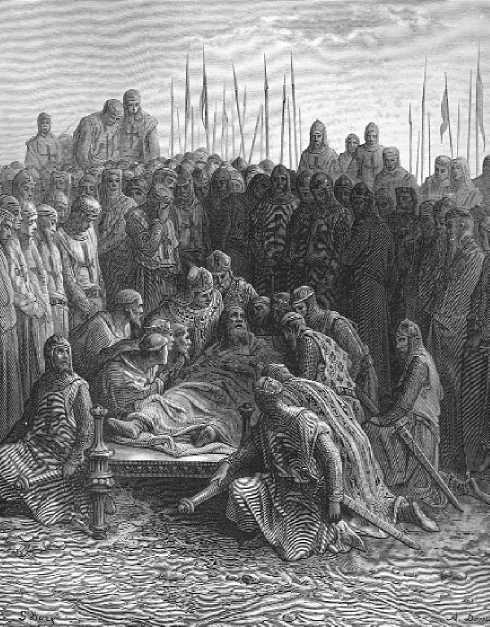A participant in the First Crusade (1096-1099) and subsequently count of Edessa (1097-1100) and first king of
Jerusalem (1100-1118).
Baldwin was the third son of Eustace II, count of Boulogne, and Ida of Bouillon, born sometime between 1061 and 1070. He was originally educated for a clerical career and held benefices in the dioceses of Liege, Reims, and Cambrai, but by 1090 he had become a knight and married Godehilde, daughter of the Norman nobleman Ralph of Tosny. When his elder brother Godfrey of Bouillon decided to take part in the First Crusade, Baldwin and his wife accompanied him.
Baldwin played an important role as one of the leaders of Godfrey’s contingent, but when the main crusading armies reached Cilicia in late 1097, he left them, with a military force recruited primarily from his brothers’ followers, evidently intending to conquer lands for himself. He contested the possession of the coastal town of Tarsos with Tancred, but in early 1098 he moved further east to conquer the area around Turbessel (mod. Tellbaflar Kalesi, Turkey) and Edessa (mod. fianliurfa, Turkey) in northern Syria, whose Armenian population had risen in revolt against the Turks. He initially shared the government of the city of Edessa with the Armenian nobleman T‘oros, but soon supplanted him, and by 1100 had extended Frankish rule for over 100 kilometers (c. 60 mi.) on either bank of the Euphrates. The county of Edessa—the first Frankish state to be established by the First Crusade—constituted an important buffer against the Turks of the Saljuq Empire, and was in a position to provide logistical help for the main crusade armies during their campaigns in the environs of Antioch during 1098. As Godehilde had died at Marash in 1097, Baldwin married the daughter of the Armenian prince Taphnuz.
When Godfrey of Bouillon died (18 July 1100), his knights summoned Baldwin to succeed to the throne of Jerusalem. He bestowed the county of Edessa on his kinsman Baldwin of Bourcq and hurried south with a small force, which reached Jerusalem in November. Unlike his brother, Baldwin insisted on a royal coronation, which was performed in the Church of the Nativity at Bethlehem at Christmas 1100 by the patriarch of Jerusalem, Daibert of Pisa, who had initially attempted to prevent Baldwin’s succession. Two years later the king managed to have Daibert deposed, and thereafter he exercised an iron rule over the Latin Church in his kingdom, although it was not until 1112 that he was able to secure the appointment of his main clerical supporter, Arnulf of Chocques, as patriarch of Jerusalem. Baldwin’s followers were predominantly Lotharingians, Normans, Picards, and Flemings, and it was from this group that most
Key appointments in the church and administration were made, although he created few lordships, preferring to reward his nobles with fiefs of revenues rather than land.
Some time after his accession Baldwin had set aside his Armenian wife, and in 1113 he married Adelaide del Vasto, widow of Roger I of Sicily, agreeing to the condition that if they had no children, the throne would pass to Adelaide’s son Roger II of Sicily. The nobility and clergy of the kingdom were largely legitimist in sentiment and favored the succession of Baldwin’s brother Eustace. When the king was thought to be in danger of dying during an illness in the winter of 1116-1117, opposition forced him to repudiate Adelaide and the marriage treaty.
Baldwin secured and greatly expanded the territory that he had inherited, defeating three major Fatimid invasions (1101, 1102, 1105) and capturing the coastal towns of Arsuf and Caesarea (1101), Acre (1104), Beirut, and Sidon (1110); his own forces were small, but he was regularly able to enlist the military support of pilgrims from the West as well as the Italian merchant republics, which he rewarded with quarters and privileges in the conquered cities, thus bringing their trading interests to the new kingdom. Baldwin’s status as the senior Frankish ruler in Outremer was manifested through his arbitration in the dispute over the county of Tripoli (1109), which recognized the claims of Bertrand of Toulouse and imposed a reconciliation on the rival parties. In 1113 Baldwin managed to repulse an invasion of Galilee by the Turks of Mosul and Damascus, despite sustaining a defeat at al-Sinnabrah; in the period of relative peace that followed he attempted to secure the eastern and southern frontiers of the kingdom, which he had already explored with reconnaissances in force in 1100 and 1107; in 1115-1116 he constructed a great castle at Shaubak in the region of Edom, which he named Montreal, and he subsequently explored the country to the south as far as the Red Sea.
The king’s last campaign (1118) was directed against Egypt, but although the army captured the coastal town of Farama (22 March), it was unwilling to advance on Cairo. Baldwin became severely ill due to the opening of an old wound, which worsened as the Franks withdrew toward Palestine. He died at El-‘Arish on 2 April, having named his brother Eustace as his heir, but recommending Baldwin of Bourcq as a successor if Eustace refused the inheritance. On 7 April Baldwin I was buried alongside his brother Godfrey in the Church of the Holy Sepulchre in Jerusalem.
-Alan V. Murray

Death of King Baldwin I of Jerusalem at El-‘Arish. (Pixel That)
Bibliography
Gindler, Paul, Graf Balduin I. von Edessa (Halle: Kaemmerer, 1901).
Hiestand, Rudolf, “Konig Balduin und sein Tanzbar,” Archiv fur Kulturgeschichte 70 (1988), 343-360.
Mayer, Hans Eberhard, Melanges sur I’histoire du royaume latin de Jerusalem (Paris: Academie des Inscriptions et Belles-Lettres, 1984), pp. 10-91.
Murray, Alan V., “Daimbert of Pisa, the Domus Godefridi and the Accession of Baldwin I of Jerusalem,” in From Clermont to Jerusalem: The Crusades and Crusader Societies, 1095-1500, ed. Alan V. Murray (Turnhout: Brepols, 1998), pp. 81-102.
-, The Crusader Kingdom of Jerusalem: A Dynastic
History, 1099-1125 (Oxford: Prosopographica et Genealogica, 2000).




 World History
World History









